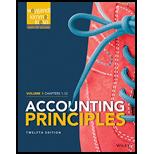
Concept explainers
(a)
Distribution of Income: In a partnership, the income of is distributed by the way of salaries, interest on the partners capital and balance income upon the agreed ratios. It is the sharing of the net income of partnership among partners.
Journalizing: It is the process of recording the transactions of an organization in a chronological order. Based on these
Accounting rules for journal entries:
- To increase balance of the account: Debit assets, expenses, losses and credit all liabilities, capital, revenue and gains.
- To decrease balance of the account: Credit assets, expenses, losses and debit all liabilities, capital, revenue and gains.
To prepare: A schedule showing the distribution of net income.
(b)
To record: The allocation of net income.
Trending nowThis is a popular solution!

Chapter 12 Solutions
Accounting Principles, Volume 1: Chapters 1 - 12
- Accounting problem with correct solutionarrow_forwardFinancial accounting 27.9.12arrow_forwardViola Enterprises purchased an item for inventory that cost $25 per unit and was priced to sell at $40. It was determined that the replacement cost is $22 per unit. Using the lower-of-cost-or-market value, what amount should be reported on the balance sheet for inventory? Helparrow_forward

 AccountingAccountingISBN:9781337272094Author:WARREN, Carl S., Reeve, James M., Duchac, Jonathan E.Publisher:Cengage Learning,
AccountingAccountingISBN:9781337272094Author:WARREN, Carl S., Reeve, James M., Duchac, Jonathan E.Publisher:Cengage Learning, Accounting Information SystemsAccountingISBN:9781337619202Author:Hall, James A.Publisher:Cengage Learning,
Accounting Information SystemsAccountingISBN:9781337619202Author:Hall, James A.Publisher:Cengage Learning, Horngren's Cost Accounting: A Managerial Emphasis...AccountingISBN:9780134475585Author:Srikant M. Datar, Madhav V. RajanPublisher:PEARSON
Horngren's Cost Accounting: A Managerial Emphasis...AccountingISBN:9780134475585Author:Srikant M. Datar, Madhav V. RajanPublisher:PEARSON Intermediate AccountingAccountingISBN:9781259722660Author:J. David Spiceland, Mark W. Nelson, Wayne M ThomasPublisher:McGraw-Hill Education
Intermediate AccountingAccountingISBN:9781259722660Author:J. David Spiceland, Mark W. Nelson, Wayne M ThomasPublisher:McGraw-Hill Education Financial and Managerial AccountingAccountingISBN:9781259726705Author:John J Wild, Ken W. Shaw, Barbara Chiappetta Fundamental Accounting PrinciplesPublisher:McGraw-Hill Education
Financial and Managerial AccountingAccountingISBN:9781259726705Author:John J Wild, Ken W. Shaw, Barbara Chiappetta Fundamental Accounting PrinciplesPublisher:McGraw-Hill Education





